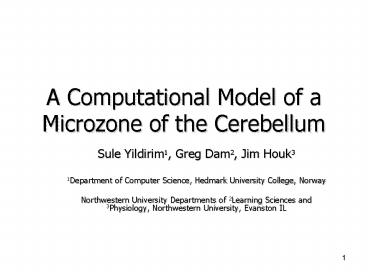A Computational Model of a Microzone of the Cerebellum - PowerPoint PPT Presentation
1 / 22
Title:
A Computational Model of a Microzone of the Cerebellum
Description:
Northwestern University Departments of 2Learning Sciences and 3Physiology, ... f: sigmoid. activation. function. 10. Non-linear dynamics (Nullclines) ... – PowerPoint PPT presentation
Number of Views:67
Avg rating:3.0/5.0
Title: A Computational Model of a Microzone of the Cerebellum
1
A Computational Model of a Microzone of the
Cerebellum
- Sule Yildirim1, Greg Dam2, Jim Houk3
- 1Department of Computer Science, Hedmark
University College, Norway - Northwestern University Departments of 2Learning
Sciences and 3Physiology, Northwestern
University, Evanston IL
2
The Purpose of the Model
- The main purpose of this model is to explore how
Purkinje cells exert control over the intensity
of firing rate of elemental motor commands. - Understand how motor commands are set and turned
off.
3
One Microscopic Module
Cerebellar Cortex
Cerebellar Nucleus
Attractor network
Motor Cortex
Elemental Motor command
Sensory cue
4
Purkinje cell
- Purkinje cell (PC) controls intensity, velocity
and duration of a movement. - Bi-stability of PC It acts like a switch that
can turn on or off a motor command with also the
help of a sensory cue.
5
The states of the attractor network
- The attractor network has two stable states that
it can be drawn to depending on - the firing rate of the Purkinje
- the strength of an input signal into the motor
cortical neuron - High state There is sustained maximum positive
feedback in the attractor network and a movement
is initiated. - Low state There is not any positive feedback in
the attractor network and the movement stops.
6
Initiation of a movement command
- Purkinje cell inhibition is off in preparation
for movement. - Sensory cue is applied into the motor cortical
neuron to initiate a movement command. - When the attractor network moves into the high
state, a constant velocity movement is commanded.
7
The method for computational modeling
- Draw phase portraits, place phase points and
observe their behavior under the effect of action
potentials of Purkinje cell, nuclear neuron and
motor cortical neuron. - Phase points move to the closest stable fixed
point. Phase points move away from unstable fixed
points.
8
Abbreviations
- m motor cortical neuron
- n nuclear neuron
- Rm the firing rate of neuron m
- Vm the membrane potential of neuron m
- Rn the firing rate of neuron n
- Vn the membrane potential of neuron n
- T constant time factor
- f activation function
- w the synaptic weight between m and n
- p the firing rate of Purkinje cell
- bb bias input to the motor cortical neuron
9
The computational microscopic model
f sigmoid activation function
T d(Vm)/dt Vm wRn - bb (1) Rm
f(Vm) (2) T d(Vn)/dt Vn wRm p (3) Rn
f(Vn) (4)
10
Non-linear dynamics(Nullclines)
- Vm nullcline Vm wRn - bb where d(Vm)/dt 0
- Vn nullcline Vn wRm - p where d(Vn)/dt 0
Vm nullcline
Vn nullcline
11
Non-linear dynamics(Fixed points)
- Points where Vm nullcline intersects Vn
nullcline.
Threshold fixed point (source)
12
Runge Kutta
Upper trajectory with initial state Vm 3.6 and
Vn -6.6
Lower trajectory with initial state Vm -2 and
Vn 8
13
Vector fields
- For each initial state (Vm, Vn), following is
calculated - d(Vm)/dt (wRn bb Vm ) / T
- d(Vn)/dt (wRm p Vn) / T
- The values of d(Vm)/dt and d(Vn)/dt define the
flow in state space followed by the attractor
network at any given initial state (Vm, Vn). - DEMO OF A STATE SPACE FOR A GIVEN p VALUE.
14
Adjustment of p value
- The current vector fields can be changed by the
adjustment of p value for a given initial (Vm,
Vn) state. - DEMO FOR A GIVEN INITIAL POINT and p VALUE IS
VARIED.
15
Bifurcation
- Sometimes the adjustment of p value can result in
the removal of a fixed point which is called a
bifurcation.
16
States of the attractor network(the model )
- High state Upper fixed point
- Low state Lower fixed point
- Threshold Middle fixed point
- Sufficient intensity Appears over threshold.
- Maximum intensity occurs at the upper fixed
point. - Lowest intensity occurs at the lower fixed point.
17
A time course for turning on/off a motor command
time
18
A simulation of the time course
DEMO
Intensity is sufficient
Intensity is weak
19
Purkinje cell discharge Premotor neuron
discharge
Summary of the Time Course for a Motor Command
Purkinje cell discharge starts
The time it takes for Vm to reach the high state.
100/1000 ms for Vm to stay at upper state.
motor command exertion
Purkinje cell firing starts
motor command exertion decays
The time it takes for Vm to reach the low state.
motor command exertion stops
Vm is at its low state.
a sensory input might appear now.
20
Simulation results
21
Regulation of movement direction
Purkinje cell discharge Premotor neuron discharge
22
References
- Ekerot CF, Oscarsson O. (1981) Prolonged
depolarization elicited in Purkinje cell
dendrites by climbing fibre impulses in the cat.
Physiol. Sep318207-21. - Holdefer RN, Miller LE, Chen LL, Houk JC.(2000)
Functional connectivity between cerebellum and
primary motor cortex in the awake monkey. J.
Neurophysiol.84585-590. - Houk, J.C. and Miller, L.E. (2001) Cerebellum
Movement regulation and cognitive functions. In
Encyclopedia of Life Sciences., Macmillan. - Houk JC, Mugnaini E. (2003) Cerebellum. In Larry
Squire's Fundamental Neuroscience, V. Motor
Systems, Chapter 32. Elsevier Science, pp.
841-872. - Houk JC (2005) Agents of the Mind, Biological
Cybernetics 92 427 - Sarrafizadeh R, Keifer J, Houk JC. (1996)
Somatosensory and movement-related properties of
red nucleus a single unit study in the turtle.
Exp Brain Res.108(1)1-17.































